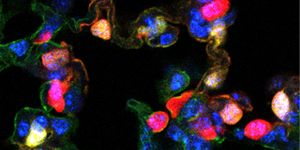Many studies indicate two or fewer alcoholic beverages a day may be good for men's hearts. But a new paper suggests danger could be a heartbeat away: more than two drinks a day in middle age may raise men's stroke risk more than hypertension (high blood pressure, HBP) or diabetes does. Furthermore, it raises risk early on, whereas stroke risk from HBP begins at age 75; diabetes, age 80.

And women? Their stroke risk rises if they drink more than a single alcoholic beverage a day.
Published in the American Heart Association (AHA) journal Stroke, the study involved 11,644 middle-aged Swedish twins who were followed for 43 years. An average of more than two drinks daily ("heavy drinking") was compared to an average of less than half a drink daily ("light drinking") by a team led by St. Anne's University Hospital statistician Pavla Kadlecova. The team found that mid-life heavy drinkers, in their 50s and 60s, have stroke five years earlier than light drinkers.
Overall, heavy drinkers had a 34 percent higher risk of stroke.
The major surprise for Kadlecova was that "alcohol consumption might be such an important risk factor for younger people (age 50 to 60 years), and that this risk is comparable with known factors (diabetes and hypertension) in later age," she told Bioscience Technology. "Shortening time to stroke by five years was quite surprising as well, but we did not possess any assumptions, as no similar analysis had been performed before. Our study shows risk factors for cardiovascular disease changes with age, which should be motivation for further research for stroke, and other cardiovascular diseases."
Most interesting to Columbia University neurologist John Brust was the study's finding that "the risk of getting stroke, due to this kind of drinking, is greatest when done in midlife, as opposed to later life." Brust was uninvolved in the research. "As Stroke is a pretty rigorous journal, this paper offers an interesting parenthesis to earlier work," he told Bioscience Technology.
Past studies
Past studies have equated heavy drinking with stroke risk. And a group publishing in Neurology last year reported that drinking more than two alcoholic drinks (one alcoholic drink equals 12 oz. of beer, 4 oz. of wine, or 1.5 oz. of 80-proof liquor, according to AHA) a day effectively aged the brains of middle aged men by six years. See the Bioscience Technology story on this.
But the large Stroke study is the first to show how the heavy drinking/stroke effect changes with age in relation to other stroke risk factors.
The current study
Kadlecova's group looked at data from the Swedish Twin Registry of same-sex twins who answered questionnaires between 1967 and 1970. All of the twins were younger than 60 at the start. As of 2010, the team had in its hands 43 years of follow-up from cause of death to hospital discharge data.
Researchers divided up the data based on high blood pressure, stroke (both ischemic and hemorrhagic), diabetes, and other cardiovascular disorders. Smoking was also factored in.
In total, about 30 percent of participants experienced a stroke. Among identical twins, those who had a stroke drank more alcohol than siblings who hadn't. This indicated that mid-life drinking raises stroke risks outside of genetics and lifestyle earlier in life.
The study jives with the AHA's recommended limit of two drinks a day (24 oz. of beer, 8 oz. of wine, 1.5 oz. 90-proof liquor) for men and half that for women.
"Our study showed that the risk of stroke associated with alcohol is moderated by age," Kadlecova told Bioscience Technology. "This could help to explain some differences in results of stroke-alcohol studies, that is, younger versus older populations, and short versus longer follow-up. Further, we used data from very long follow-up. In general, for comparison of results you should look at what population was studied, what was the follow-up, and what was the reference group. We chose very-light drinkers-as opposed to nondrinkers-as the reference category to avoid potential bias caused by ex-drinkers who had stopped drinking alcohol for health problems, and may possess pre-existing susceptibilities."
Hemorrhagic (bleeding) strokes predominated
Past studies have found, by contrast, that light to moderate drinking can be beneficial to the cardiovascular system, generally. Light to moderate drinking may even be protective against one specific form of stroke: ischemic stroke. (Ischemic stroke is caused by clots blocking blood flow in the brain. Hemorrhagic stroke is caused by bleeding in the brain.)
In the current study, the vast majority of strokes among heavy drinkers were hemorrhagic, involving leaking blood. There were far fewer ischemic strokes.
One reason for this, the Kadlecova group reported, is that light to moderate amounts of alcohol may improve the blood flow that is blocked in ischemic stroke (versus flowing too heavily, in hemorrhagic stroke). "Because of a relatively low number of hemorrhagic events (406 cases), we focused our analyses on the overall risk of stroke," the team wrote. "Still, the analysis by subtype of stroke showed that risk of hemorrhagic stroke for heavy alcohol consumers is high relative to ischemic stroke. It may be that alcohol consumption could protect against ischemic stroke to some extent by improving thrombolytic profile and increasing blood flow."
But the study emphasized that "light to moderate drinking" differs dramatically in men and women. "Moderate alcohol consumption (consuming 1-2 drinks/d on average) in women showed similarly harmful effect as heavy drinking (>2 drinks/d on average) in men," the team wrote. This is "in accordance with the American Heart Association recommendations: Men should consume no more than 2 drinks/d, and nonpregnant women should consume no more than 1 drink/d."
Why would drinking in midlife have a greater impact on stroke risk than drinking in later life? "In my opinion," Kadlecova concluded to Bioscience Technology, "it is due to the fact that in older age, the disease risk factors for diabetes and hypertension are more important. In younger age those diseases are not so developed."









